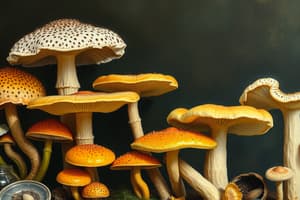Podcast
Questions and Answers
What are the characteristics of Chytridiomycota?
What are the characteristics of Chytridiomycota?
Flagellate, aquatic, mostly decomposers, some pathogenic.
What are the characteristics of Zygomycota?
What are the characteristics of Zygomycota?
Multinucleate hyphae aseptate, except in reproductive structure; decomposers and pathogens.
What are the characteristics of Glomeromycota?
What are the characteristics of Glomeromycota?
Multinucleate hyphae aseptate; form AM associations.
What are the characteristics of Ascomycota?
What are the characteristics of Ascomycota?
What are the characteristics of Basidiomycota?
What are the characteristics of Basidiomycota?
What fungi in our lab can only reproduce asexually?
What fungi in our lab can only reproduce asexually?
Give an example of Glomeromycetes.
Give an example of Glomeromycetes.
Name an example of Chytridiomycetes.
Name an example of Chytridiomycetes.
Name an example of Zygomycetes.
Name an example of Zygomycetes.
Name examples of Ascomycetes.
Name examples of Ascomycetes.
Name examples of Basidiomycetes.
Name examples of Basidiomycetes.
The asexual reproduction of Chytridiomycota involves ______.
The asexual reproduction of Chytridiomycota involves ______.
The sexual reproduction of Zygomycota occurs through ______.
The sexual reproduction of Zygomycota occurs through ______.
Glomeromycota reproduce asexually with ______.
Glomeromycota reproduce asexually with ______.
Ascomycetes reproduce sexually with ______.
Ascomycetes reproduce sexually with ______.
Basidiomycota reproduce sexually with ______.
Basidiomycota reproduce sexually with ______.
What are the beneficial roles of fungi? (Select all that apply)
What are the beneficial roles of fungi? (Select all that apply)
What are some harmful effects of fungi? (Select all that apply)
What are some harmful effects of fungi? (Select all that apply)
What is an annulus?
What is an annulus?
What are gills in fungi?
What are gills in fungi?
What is the pileus in fungi?
What is the pileus in fungi?
What is a stipe in fungi?
What is a stipe in fungi?
What is a volva in fungi?
What is a volva in fungi?
Flashcards are hidden until you start studying
Study Notes
Characteristics of Fungi Groups
- Chytridiomycota: Flagellate, aquatic fungi primarily functioning as decomposers, with some being pathogenic.
- Zygomycota: Composed of multinucleate, aseptate hyphae (excluding reproductive structures); serve as decomposers and pathogens.
- Glomeromycota: Feature multinucleate, aseptate hyphae; form arbuscular mycorrhizal (AM) associations with plant roots.
- Ascomycota: Known for their role as decomposers and pathogens; many species form lichens and some establish mycorrhizal relationships.
- Basidiomycota: Primarily decomposers; a number form mycorrhizal associations, with fewer species involving in lichen formation.
Reproductive Strategies
- Chytridiomycota:
- Asexual: Diploid flagellate zoospores.
- Sexual: Involves haploid gametes.
- Zygomycota:
- Asexual: Produces nonflagellate spores in sporangia.
- Sexual: Fusion of hyphae creates a zygosporangium for meiosis.
- Glomeromycota: Only reproduce asexually through large, nonflagellate, multinucleate spores.
- Ascomycota:
- Asexual: Produces conidia.
- Sexual: Forms nonflagellate spores (ascospores) in sacs (asci) on ascocarps.
- Basidiomycota:
- Asexual: Several spore types.
- Sexual: Nonflagellate spores (basidiospores) generated on club-shaped basidia of basidiocarps.
Examples of Fungi
- Glomeromycetes: Glomus, known for AM fungi.
- Chytridiomycetes: Include Allomyces and Batrachochytrium dendrobatidis (Bd).
- Zygomycetes: Include Rhizopus and Pilobolus.
- Ascomycetes: Include truffles, morels, common mold, and yeast.
- Basidiomycetes: Include mushrooms, toadstools, and rusts.
Benefits of Fungi
- Serve as a food source and are used in lab experiments.
- Yeast aids in fermentation for alcoholic beverages like wine and beer.
- Production of enzymes (amylase, pectinase) and antibiotics (penicillin, streptomycin).
- Contributions to medicine (e.g. ergotine) and organic acids (citric, lactic).
- Agricultural benefits include decomposition, soil fertility enhancement, and symbiotic relationships with plants, producing hormones such as Gibberellin.
Harmful Effects of Fungi
- Cause food spoilage, leading to economic loss.
- Inflict damage in the silk industry by targeting silkworms.
- Responsible for several plant diseases and human health issues, including candidal vulvovaginitis.
- Damage to textiles, paper, leather goods, rubber, and optical instruments.
- Some fungi are highly toxic in certain regions.
Fungal Structure Terms
- Annulus: A ring-like structure on a mushroom stalk.
- Gills: Structures under the cap where spores are produced.
- Pileus: The cap of a mushroom.
- Stipe: The stalk of a mushroom.
- Volva: A cup-like structure at the base of certain mushrooms.
Studying That Suits You
Use AI to generate personalized quizzes and flashcards to suit your learning preferences.




